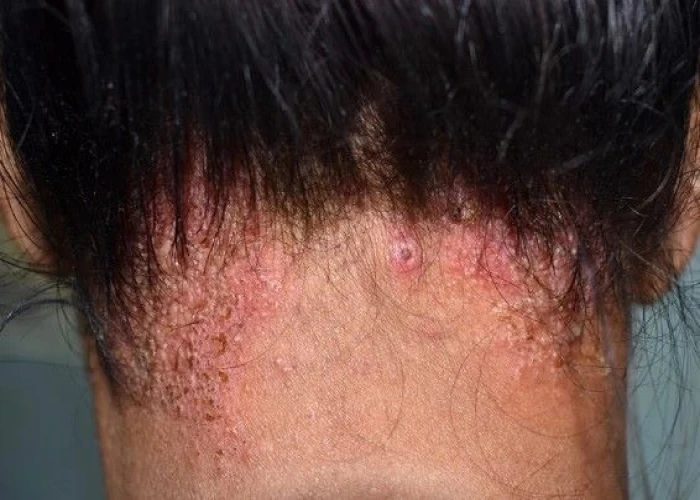 Welcome
Welcome
“May all be happy, may all be healed, may all be at peace and may no one ever suffer."
Ringworm (scalp)

Ringworm of the scalp, also known as tinea capitis, is a fungal infection that affects the scalp and hair shafts. It is most common in children but can also occur in adults.
The infection is usually caused by the fungus Trichophyton tonsurans, which can live on the skin and scalp. It is highly contagious and can be spread through direct contact with an infected person, animal, or object, such as combs, brushes, or hats.
Symptoms of scalp ringworm may include a scaly, red rash on the scalp, itching, hair loss, and the appearance of black dots or broken hairs. The rash may also be accompanied by swelling or pus-filled bumps.
Treatment for scalp ringworm typically involves the use of antifungal medication, such as oral medications or antifungal shampoos. In severe cases, a combination of treatments may be necessary. It is important to follow the treatment plan as prescribed and to complete the full course of medication, even if symptoms improve before the medication is finished.
Prevention of scalp ringworm involves avoiding contact with infected people or animals and not sharing personal items such as combs, brushes, or hats. Maintaining good hygiene practices and washing hands regularly can also help prevent the spread of infection.
Scalp ringworm can be a serious condition if left untreated and can lead to permanent hair loss or scarring. If you suspect that you or someone else may have scalp ringworm, it is important to seek medical attention to prevent the spread of infection and to receive appropriate treatment.
Research Papers
Disease Signs and Symptoms
- Dry scaly skin
- Itchy scalp
- Brittle or fragile hair that easily pulls out
- Ringworm
Disease Causes
Ringworm (scalp)
Ringworm of the scalp is caused by a common fungus. The fungus attacks the outer layer of skin on the scalp and the hair. This causes those hairs to break. The condition can be spread in the following ways:
- Human to human. Ringworm often spreads through direct skin-to-skin contact with an infected person.
- Animal to human. You can contract ringworm by touching an animal with ringworm. Ringworm can spread while petting or grooming dogs or cats with ringworm. Ringworm is fairly common in kittens, puppies, cows, goats, pigs and horses.
- Object to human. It's possible for ringworm to spread by contact with objects or surfaces that an infected person or animal has recently touched. This includes items such as clothing, towels, bedding, combs and brushes.
Disease Prevents
Ringworm (scalp)
Ringworm of the scalp is difficult to prevent. The fungus that causes it is common, and the condition is contagious even before symptoms appear. Take these steps to reduce the risk of ringworm:
- Educate yourself and others. Be aware of the risk of ringworm from infected people or pets. Tell children about ringworm, what to watch for and how to avoid the infection.
- Shampoo regularly. Be sure to wash your child's scalp regularly, especially after haircuts. Some scalp conditioning products, such as coconut oil and pomades with selenium, might help prevent ringworm of the scalp.
- Keep skin clean and dry. Be sure children wash their hands, including after playing with pets. Keep shared areas clean, especially in schools, child care centers, gyms and locker rooms.
- Avoid infected animals. The infection often looks like a patch of skin where fur is missing. If you have pets or other animals that commonly carry ringworm, ask your veterinarian to check them for the infection.
- Avoid sharing personal items. Teach children not to let others use their clothing, towels, hairbrushes, sports gear or other personal items.
Disease Treatments
Treatment for ringworm of the scalp requires a prescription-strength antifungal medication taken by mouth. The first-choice medication is usually griseofulvin (Gris-Peg). Alternatives might be used if griseofulvin isn't working or your child is allergic to it. These include terbinafine, itraconazole (Spoanox, Tolsura) and fluconazole (Diflucan). Your child might need to take one of these medications for six weeks or more — until hair regrows. Typically, with successful treatment, the bald spots will grow hair again and the skin will heal without scarring.
Your doctor might recommend that you also wash your child's hair with a prescription-strength medicated shampoo. The shampoo removes fungus spores and helps prevent spreading the infection to others or to other areas of the body.
There is no need to shave the head or cut the hair as part of the treatment.
Disease Diagnoses
Disease Allopathic Generics
-
Griseofulvin [Microsize]
Medicines containing griseofulvin for ringworm anywhere on the body.
1 pill at night after meal for 4 weeks. Tinea capitis and tinea anguium require 5-9 months of treatment.
-
Fluconazole
Pregnant women are prohibited.
-
Chlorpheniramine Maleate
Medicines containing chlorpheniramine maleate should be given.
1/2 teaspoon or 1 pill 3 times a day.
-
Clotrimazole (Topical)
Ointment can be used for ringworm, fungal infections or eczema.
How much cream should be applied 2/3 times a day.
-
Miconazole Nitrate (Topical)
Ointment can be used for ringworm, fungal infections or eczema.
How much cream should be applied 2/3 times a day.
Disease Ayurvedic Generics
Disease Homeopathic Generics
-
Acid nitricum
30
-
Petroleum
30
-
Bacillinum
30, 200
-
Juglans cinerea
6, 30
-
Sepia
1X, 200
-
Graphites
30, 200
-
Phosphorus
6, 30
-
Staphysagria
30, 200
-
Tellurium
30
Disease yoga
Ringworm (scalp) and Learn More about Diseases

Hereditary hemorrhagic telangiectasia

Heart arrhythmia

Transient ischemic attack (TIA)

Cervical dystonia

Primary biliary cholangitis

Cutaneous T-cell lymphoma

Recurrent breast cancer

Bladder stones
scalp ringworm, মাথার ত্বকের দাদ
To be happy, beautiful, healthy, wealthy, hale and long-lived stay with DM3S.
